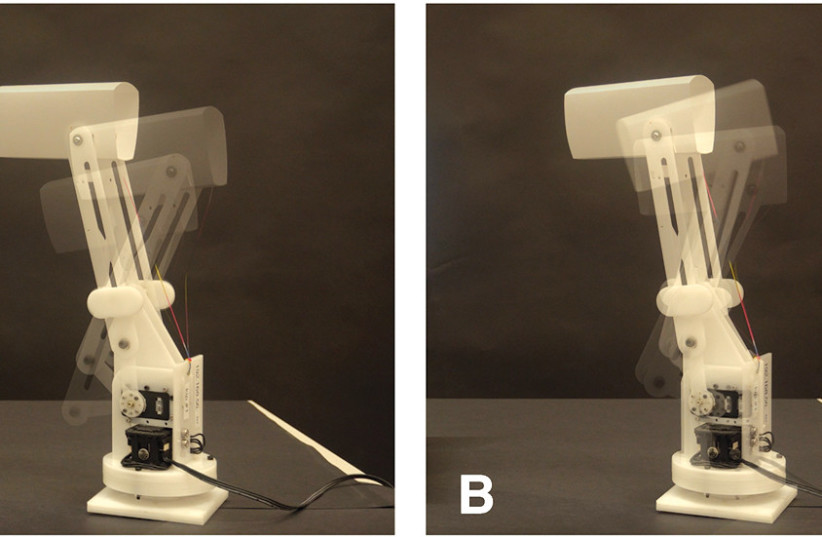Can socially awkward situations be made less awkward and in turn lead to better interactions, with the help of humorous robots?
The Jerusalem Report met up with Viva Sarah Press to discuss her MA thesis on humor and robotics, in Tel Aviv, in the middle of a storm. Despite the gray weather, the meeting was full of laughs, especially when she brought out the red clown nose she always carries, “just in case.”
Press prepared her thesis, titled “Humorous Robotic Behavior as a New Approach to Mitigating Social Awkwardness,” with the assistance of her MA adviser Dr. Hadas Erel. Press underwent an unconventional process to begin her Master’s in Human Computer Interaction at Reichman University (RU).
Born and raised in Canada, she made aliyah in 1998. Five days later she began her media career in Israel at The Jerusalem Post. Since then, she has worked at numerous media outlets in senior roles, focusing on innovation. She teaches journalism at RU and gives lectures on innovation to groups, including a talk on humorous technology which is based on her MA research.
Press first experienced the power of humor after interviewing members of the Dream Doctors Project, medical clowns who provide emotional relief to patients and their families.

Intrigued by their work, Press decided to take a course in medical clowning at Kibbutzim College, alongside a second certification course in educational clowning for schools. She worked and volunteered as a clown for a period, but ultimately felt it “wasn’t my vocation,” although she “enjoyed learning about it.”
This is what drives Press: “I love learning new things, and diverse topics,” she says.
It was this attitude of hers that led a friend to recommend a degree in HCI.
Press’s first idea for a thesis topic was the concept of failure. She loves “the idea of failure in that you can really learn from it,” she says. Admittedly, she doesn’t think “it is taught well in schools,” as it is important “to find the lessons gained from failing.”
“Somewhere along the way we forget what failure is,” she says. “We need to teach kids to fail right.”
However, she adds with a laugh, “You can say I failed at figuring out how to combine failure with robotics.”
This “failure” led to Press’s next-in-line thesis topic: humor.
How to combine robots, humor, and therapy
She knew from her therapeutic clowning training and her research that humor has an amazing impact on people. As she dived deeper into the subject, she realized that most studies focus primarily on how humor can improve the interaction between humans and technology. But she wondered specifically how technology that is humorous can impact us.
This led to the publication of two papers, the first a validation study (or “poster” as they are referred to in the academic world), and the second full research paper.
Press’s paper focused on the context of “social awkwardness” and in particular, how humorous technology can impact how people interact with each other.
The way she tackled this was to recreate a setting that promoted social awkwardness.
To do this Press put two random people in a room together, seated in chairs taped to the ground 55 centimeters apart. The barrier for “comfortable conversation distance” is known to be 76cm. In essence, she “broke” the barrier. The participants would then sit there in social awkwardness, with a robotic object that looked like a lamp, on a table beside them. For the first minute, the robot did not move at all, forcing the strangers to confront the situation they were in. Then, depending on whether it was a control or experimental group, the robot would make humorous or non-humorous movements.
Press put together her MA thesis at the Media Innovation Lab at RU, using one of their non-humanoid robots for her research. Together with Erel, who is head of social human-robot interaction research at miLAB, an animator and a clown therapist, Press was able to get the machine to perform humorous movements. She then showed how nonverbal robotic humor could invoke a change in the way people interact.
Press’s full research was published and presented in April 2023 at the Conference on Human Factors in Computing Systems – the premier international conference of Human-Computer Interaction – held in Hamburg, Germany; and she was scheduled to present it again in July at IsraHCI at RU.
She says the feedback has been predominantly positive, with “a lot of interest,” particularly in how she created the movements. In general, Press sees the implementation of humorous technology as important because it can affect how our technologies impact us. “Many of the big tech companies research humor, though they tend to focus on verbal or text humor.”
She is generally optimistic about the future, specifically if tech can “move in ways that could positively impact the way people interact with each other.” She really believes in its ability, as evidenced by her research.
“That’s the thing with humor, it can invoke positive interactions.”
As for what comes next for Press, she says, “I don’t know, but something new for sure.”
Her yearning to learn and discover new things continues. Referring to her career in journalism, she said, “It opens your mind… you are interacting with people from all walks of life and different professions. It really makes you want to learn more.”
Thanks to Press’s inquiring mind and love of innovation, we now know that robotic humor can build bridges between people, allowing for the free flow of knowledge and connection. ■
